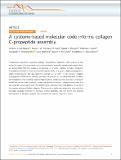A cysteine-based molecular code informs collagen C-propeptide assembly
Author(s)
DiChiara, Andrew Stephen; Li, Rasia C.; Suen, Patreece H.; Hosseini, Azade S.; Taylor, Rebecca J.; Weickhardt, Alexander F.; Malhotra, Diya; Shoulders, Matthew D.; ... Show more Show less
DownloadPublished version (2.230Mb)
Terms of use
Metadata
Show full item recordAbstract
Fundamental questions regarding collagen biosynthesis, especially with respect to the molecular origins of homotrimeric versus heterotrimeric assembly, remain unanswered. Here, we demonstrate that the presence or absence of a single cysteine in type-I collagen’s C-propeptide domain is a key factor governing the ability of a given collagen polypeptide to stably homotrimerize. We also identify a critical role for Ca2+ in non-covalent collagen C-propeptide trimerization, thereby priming the protein for disulfide-mediated covalent immortalization. The resulting cysteine-based code for stable assembly provides a molecular model that can be used to predict, a priori, the identity of not just collagen homotrimers, but also naturally occurring 2:1 and 1:1:1 heterotrimers. Moreover, the code applies across all of the sequence-diverse fibrillar collagens. These results provide new insight into how evolution leverages disulfide networks to fine-tune protein assembly, and will inform the ongoing development of designer proteins that assemble into specific oligomeric forms.
Date issued
2018-10Department
Massachusetts Institute of Technology. Department of Chemistry; McGovern Institute for Brain Research at MITJournal
Nature Communications
Publisher
Springer Science and Business Media LLC
Citation
DiChiara, Andrew S. et al. “A cysteine-based molecular code informs collagen C-propeptide assembly.” Nature Communications 9 (2018): 4206 © 2018 The Author(s)
Version: Final published version
ISSN
2041-1723